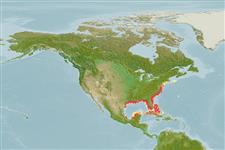Classification / Names
Common names from other countries
Main reference
Size / Weight / Age
Max length : 91.0 cm FL male/unsexed; (Ref. 40637); max. published weight: 5.9 kg (Ref. 40637); max. reported age: 5 years (Ref. 72462)
Length at first maturity
Lm 43.0, range 25 - 51.2 cm
Environment
Marine; pelagic-neritic; oceanodromous (Ref. 51243); depth range 10 - 35 m (Ref. 26912)
Climate / Range
Subtropical; 20°C - 30°C (Ref. 54882), preferred 24°C (Ref. 107945); 44°N - 19°N, 97°W - 64°W (Ref. 54882)
Distribution
Western Atlantic: Canada (Ref. 5951) to Cape Cod to Miami (USA) and Gulf of Mexico coasts from Florida, USA to Yucatan, Mexico. Three species namely: Scomberomorus tritor in eastern Atlantic, Scomberomorus sierra in eastern Pacific, and Scomberomorus brasiliensis in the Caribbean and Atlantic coast of South America have often been confused with this species. Absent in the Bahamas (Ref. 26938).
Countries | FAO areas | Ecosystems | Occurrences | Introductions
Short description
Dorsal
spines
(total): 17 - 19;
Dorsal
soft rays
(total): 17-20;
Anal
soft rays: 17 - 20;
Vertebrae: 51 - 53. Interpelvic process small and bifid. Lateral line gradually curving down toward caudal peduncle. Vertebrae 21-22 precaudal plus 30-31 caudal, total 51-53. Intestine with 2 folds and 3 limbs. Swim bladder absent. Body covered with small scales. First dorsal fin black anteriorly and at distal margin posteriorly. Generally silvery with sides marked with about three rows of round to elliptical dark spots (orange in life).
IUCN Red List Status (Ref. 115185)
Threat to humans
Reports of ciguatera poisoning (Ref. 31172)
Human uses
Fisheries: highly commercial; gamefish: yes
Tools
Special reports
Download XML
Internet sources
Estimates of some properties based on models
Phylogenetic diversity index
PD50 = 0.5000 many relatives (e.g. carps) 0.5 - 2.0 few relatives (e.g. lungfishes)
Trophic Level
4.5 ±0.5 se; Based on diet studies.
Resilience
Medium, minimum population doubling time 1.4 - 4.4 years (K=0.2-0.38; tm=2-3; Fec=280,000)
Vulnerability
Moderate vulnerability (39 of 100)
Price category
